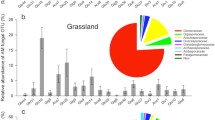Abstract
Arbuscular mycorrhizal (AM) fungi are vital soil microbes that connect many individual plants into a large functional organism via a vast mycelial network under the ground. In this study, the changes of soil AM fungal community in response to road-building disturbance caused by tourism development in Huangshan (Yellow Mountain) Scenic Area are assessed. Road building have brought negative effects on AM fungal community, inducing lower diversity parameters, including species number, spore density and diversity indices. However, the dominant genus and species of AM fungi which play key roles in the AM fungal community composition are quite similar before and after road building. Moreover, there are no significant differences in species richness of AM fungi associated with plants, suggesting the tolerance of AM fungal community to the disturbance of road building.


Similar content being viewed by others
References
An ZQ, Hendrix JW, Hershman DE, Henson GT (1990) Evaluation of the ‘‘most probable number’’ (MPN) and wet-sieving methods for determining soil-borne populations of endogonaceous mycorrhizal fungi. Mycologia 82:576–581
Barni E, Siniscalco C (2000) Vegetation dynamics and arbuscular mycorrhiza in old-field successions of the western Italian Alps. Mycorrhiza 10:63–72
Boerner REJ, DeMars BG, Leicht PN (1996) Spatial patterns of mycorrhizal infectiveness of soils long a successional chronosequence. Mycorrhiza 6(2):79–90
Brundrett MC, Ashwath N (2013) Glomeromycotan mycorrhizal fungi from tropical Australia III. Measuring diversity in natural and disturbed habitats. Plant Soil 370(1–2):419–433
Eagles PFJ, Bowman ME, Tao TCH (2001) Guidelines for tourism in parks and protected areas of East Asia. IUCN, Gland
Guadarrama P, Castillo S, Ramos-Zapata JA, Hernández-Cuevas LV, Camargo-Ricalde SL (2014) Arbuscular mycorrhizal fungal communities in changing environments: the effects of seasonality and anthropogenic disturbance in a seasonal dry forest. Pedobiologia 57(2):87–95
Habte M (1989) Impact of simulated erosion on the abundance and activity of indigenous vesicular-arbuscular mycorrhizal endophytes in an Oxisol. Biol Fert Soils 7:164–167
Hart MM, Klironomos JN (2003) Diversity of arbuscular mycorrhizal fungi and ecosystem functioning. In: van der Heijden MGA, Sanders IR (eds) Mycorrhizal ecology. ecological studies (analysis and synthesis), vol 157. Springer, Berlin, pp 225–242
Helgason T, Daniell TJ, Husband R, Fitter AH, Young JP (1998) Ploughing up the wood-wide web? Nature 394(6692):431
Hepper CM (1984) Isolation and culture of VA mycorrhizal (VAM) fungi. In: Powell CL, Bagyaraj DJ (eds) VA mycorrhizae. CRC, Florida, pp 95–112
Johnson NC, Zak DR, Tilman D, Pfleger FL (1991) International association for ecology dynamics of vesicular-arbuscular mycorrhizae during old field succession. Oevologia 86(3):349–358
Klironomos JN, Zobel M, Tibbett M, Stock WD, Rillig MC, Parrent JL, Moora M, Koch AM, Facelli JM, Facelli E, Dickie IA, Bever JD (2011) Forces that structure plant communities: quantifying the importance of the mycorrhizal symbiosis. New Phytol 189:366–370
Koide RT, Mosse B (2004) A history of research on arbuscular mycorrhiza. Mycorrhiza 14:145–163
Lekberg Y, Schnoor T, Kjøller R, Gibbons SM, Hansen LH, Al-Soud WA, Sørensen SJ, Rosendahl S (2012) 454-sequencing reveals stochastic local reassembly and high disturbance tolerance within arbuscular mycorrhizal fungal communities. J Ecol 100:151–160
Rosendahl S, Matzen HB (2008) Genetic structure of arbuscular mycorrhizal populations in fallow and cultivated soils. New Phytol 179(4):1154–1161
Schnoor TK, Lekberg Y, Rosendahl S, Olsson PA (2011) Mechanical soil disturbance as a determinant of arbuscular mycorrhizal fungal communities in semi-natural grassland. Mycorrhiza 21(3):211–220
Sharmah D, Jha DK (2014) Diversity of arbuscular mycorrhizal fungi in disturbed and undisturbed forests of Karbi Anglong Hills of Assam, India. Agri Rsch 3:229–238
Soteras F, Grilli G, Cofré MN, Marro N, Becerra A (2015) Arbuscular mycorrhizal fungal composition in high montane forests with different disturbance histories in Central Argentina. Appl Soil Ecol 85:30–37
Stover HJ, Thorn RG, Bowles JM, Bernards MA, Jacobs CR (2012) Arbuscular mycorrhizal fungi and vascular plant species abundance and community structure in tallgrass prairies with varying agricultural disturbance histories. Appl Soil Ecol 60:61–70
Su YY, Guo LD (2007) Arbuscular mycorrhizal fungi in non-gazed, restored and over-gazed grassland in the Inner Mongolia steppe. Mycorrhiza 17:689–693
van der Heijden MGA, Klironomo JN, Ursic M, Moutoglis P, Streitwolf-Engel R, Boller T, Wiemken A, Sanders IR (1998) Mycorrhizal fungal diversity determines plant biodiversity, ecosystem variability and productivity. Nature 396:69–72
van der Heyde M, Ohsowski B, Abbott LK, Hart M (2017) Arbuscular mycorrhizal fungus responses to disturbance are context-dependent. Mycorrhiza 27:431–440
Wagg C, Bender SF, Widmer F, van der Heijden MGA (2014) Soil biodiversity and soil community composition determine ecosystem Multifunctionality. Proc Nat Acad Sci USA 111(14):5266–5270
Yang AN, Lu L, Zhang N (2011) The diversity of arbuscular mycorrhizal fungi in the subtropical forest of Huangshan (Yellow Mountain), East-central China. World J Microb Biot 27:2351–2358
Yang AN, Hu JL, Lin XG, Zhu AN, Wang JH, Dai J, Wong MH (2012) Arbuscular mycorrhizal fungal community structure and diversity in response to 3-year conservation tillage management in a sandy loam soil in North China. J Soil Sediment 12(6):835–843
Acknowledgements
This study is supported by National Natural Science Foundation of China (31600026, 41371162), Key Projects of Natural Science research in Universities of Anhui Province (KJ2016A276) and Initial Foundation for Ph. D in Anhui Normal University (2014bsqdjj50). We are grateful to Charles Duncan and Hilary Duncan, Dr. Junli Hu for their advices in improving the manuscript. We thank the supports from Anhui Provincial Key Lab of the Conservation and Exploitation of Biological Resources, Foundation for Young teachers in Anhui Normal University.
Author information
Authors and Affiliations
Corresponding author
Rights and permissions
About this article
Cite this article
Yang, A., Tang, D., **, X. et al. The effects of road building on arbuscular mycorrhizal fungal diversity in Huangshan Scenic Area. World J Microbiol Biotechnol 34, 30 (2018). https://doi.org/10.1007/s11274-017-2404-5
Received:
Accepted:
Published:
DOI: https://doi.org/10.1007/s11274-017-2404-5




